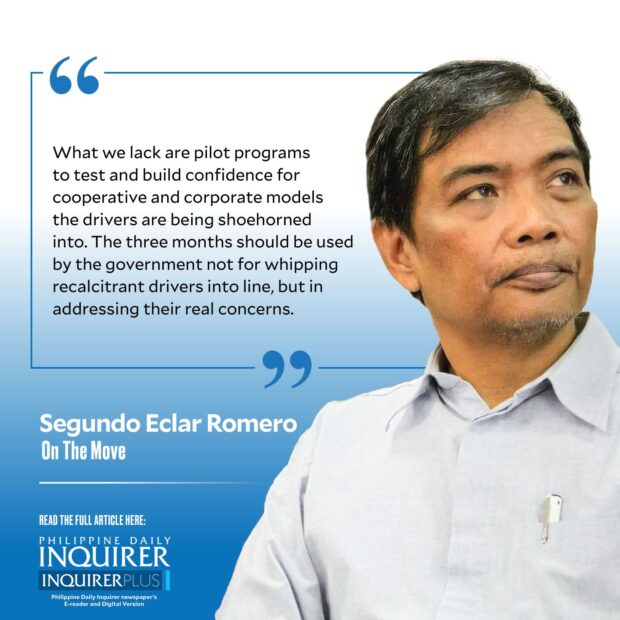A government without imagination

President Marcos extended the government’s deadline for jeepney drivers to consolidate themselves into cooperatives or corporations until April 30. This government does not get it—there is something extremely wrong with the design of this PUV modernization program. Only half of the jeepneys in Metro Manila have consolidated. Instead of using the reprieve for the government to check its coercive approach to the problem, it should be putting together people who can shed light on why jeepney drivers and operators adamantly refuse to consolidate.
It is a waste of time to extend the deadline by another three months, only so the drivers and operators can be subjected to more creative coercion with the end-in-view of making them consolidate into unknown and unfamiliar juridical persons—cooperatives and corporations—that will take over their livelihood.
There is a reason why the jeepneys and PUV Express are more resilient on the streets of Metro Manila. Public utility vehicles have to compete with the overwhelming number of private vehicles on the road, and the footprint of the jeepney and the PUV Express gives them a chance. This is also the reason motorcycles are becoming more popular than even jeepneys and PUV Express, because of their nimbleness. Jeepneys can navigate narrow streets and are capable of frequent, informal stops. They are now the choice of many passengers for short as well as long trips.
Many people do not know that mini-buses like what are masquerading as modern jeepneys already competed toe-to-toe with jeepneys in the 1960s. I remember those “Thames” mini-buses plying the streets of Metro Manila during that era. Why they have become extinct, and why they are being resurrected through legal fiat does not take into consideration why Filipinos have found the jeepney as a more fit-for-purpose public utility vehicle.
Converting jeepneys into mini-buses, even if these are called modern jeepneys, will be stuck in inescapable traffic because of their size. The bright boys who thought of upgrading the jeepney into a minibus do not realize that in the streets of Metro Manila, whose transport infrastructure is hopelessly car-centric, size matters.
Jeepneys, unlike mini-buses, are also easier to get in and out of because of their permanently open rear entry mode. Passengers can also slide up and down and adjust themselves as appropriate. The bridge of hands that conveys fares to the driver is also a feature that enables strangers to participate in a collective activity. Everybody gets seated in a jeepney, unlike in mini-buses. With only the footprint of an SUV, a jeepney carries 22 passengers.
Jeepney drivers pay for fuel, repairs, and maintenance. Cooperatives and corporations will change this. These are mini-bureaucracies. Maintenance will likely be centralized and repair costs distributed according to shares. Jeepney drivers work independently, setting their schedules, taking breaks, and doing family errands as needed. Cooperatives and corporations will change this work-life balance, implementing fixed schedules, shift rotation, and controlling the private use of vehicles. In case a driver has a complaint against the cooperative or other drivers, how will he navigate the grievance procedures? Can drivers on their own navigate the contractual arrangements that govern these problem scenarios contractual arrangements?
The consolidation of jeepneys into cooperatives and corporations is the end of the poor Filipino as a rugged transport entrepreneur. Owning and operating a jeepney remains one of the most attractive self-employment options for many Filipinos, despite its risks, because they can comprehend the totality of the business, unlike being in a cooperative or corporation, where they will tangle not only with traffic enforcers but a lot of unfamiliar procedures and untrustworthy strangers.
What we lack are pilot programs to test and build confidence for cooperative and corporate models the drivers are being shoehorned into. The three months should be used by the government not for whipping recalcitrant drivers into line, but in addressing their real concerns.
It’s a shame that the larger public has not gone out of their way to find creative solutions to the problem. Where are our innovators, intrapreneurs, futurists, and simulators? Where are our transport planners and centers ensconced in our public universities? Mr. Marcos should enjoin his transport bureaucrats to open their minds and encourage experts and the public to actively find creative solutions to the problem through piloting, prototyping, and co-designing options with the primary stakeholders until they find what works.
doyromero@gmail.com




















